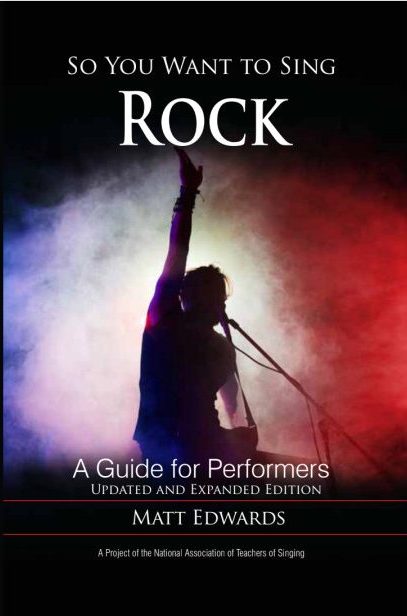The Singer’s Library: So You Want to Sing Rock

When author and pedagogue Matthew Edwards wrote So You Want to Sing Rock ‘n’ Roll (Rowman & Littlefield, 2014), it was only the second book in the NATS-sponsored So You Want to Sing series. In the decade since, the set has expanded to 20 books covering a range of genres and topics. The authors and editors are now circling back to some of the earlier volumes for updates, the first of which was Amanda Flynn’s So You Want to Sing Musical Theatre (Rowman & Littlefield, 2022), an expanded take on Karen Hall’s So You Want to Sing Music Theater. Edwards has similarly returned to his previous work for revisions and additions, all of which appear in the new So You Want to Sing Rock. In the interview below, Edwards outlines what readers can expect from the new volume and explains some of the impetus behind the changes and inclusions.

The current edition of So You Want to Sing Rock is billed as an “updated and expanded” version, implying that it contains new information related to previous content as well as additional content. Can you give us an example of each that readers can expect to find in the new book?
When I wrote the first edition, I was working with a lot of singers who had specific tonal goals in mind. My approach focused heavily on technique, and I trusted the artist to bring the rest. At the time, social media was still image-driven, and while YouTube was gaining traction, its full impact hadn’t hit yet. Since then, platforms like YouTube, TikTok, and Instagram have experienced explosive growth, and the music industry has undergone a complete transformation.
Artists today feel less pressure to conform because they can use social media to connect with an audience by being authentically themselves. In a virtual world with 1.8 billion users, there’s room for everyone. As the industry evolved, I found myself working with more artists who wanted to develop their own unique sound. So this edition reflects that shift in my teaching. It still emphasizes technique, but it also encourages singers to explore the full range of motion of their voice while deeply studying the artists they admire, allowing those influences to shape their own signature sound.
Many of the technical exercises remain in the second edition, but the way the book is organized is clearer, and I think it ties the chapters together more effectively than the first edition did.
Most readers have probably heard of the “fight, flight, or freeze” response, especially as it relates to performance anxiety. But in the introduction, you discuss how the same phenomenon can relate to how singers approach practicing. Can you describe that here? How can singers use this awareness to build better practice habits?
I’ve seen these patterns emerge consistently over my twenty years of teaching. Some singers are highly motivated—they’ll tell you what’s holding them back, and when you show them a way forward, they dive in and make it happen. They’re the fighters.
Then there are singers who want to improve but aren’t quite ready to make changes. They might resist new approaches or avoid fully committing to them. This is a common phase, often rooted in a lack of trust—either in themselves or in the process. As a teacher, the key is helping them understand how learning actually works and how cognitive distortions can get in their way. Once they learn to manage their thoughts, they start taking more risks and making real progress.
Then there’s the freeze response—singers who have taken in so much feedback over time that they’re stuck in analysis paralysis. They’re trying to please everyone and have lost sight of who they are as artists. For them, the work is about clarifying their identity, sorting through what they’ve learned, and focusing on what they want to say.
When singers understand these patterns, they start to recognize what their mind is doing and create new thought patterns that keep them in a growth mindset.

Since your first edition, there is another common chapter in the So You Want to Sing series: “How Learning Works: An Introduction to Motor Learning Theory” by Lynn Helding. You have incorporated two additional guest chapters in this new edition: “A Listening Journey through the History of Rock ‘n’ Roll” by Jacqlyn Zito-Edwards and “Navigating through an Ever-Evolving Musical Landscape” by Rod Vester. What do you feel these chapters add to the book?
The chapter on learning reinforces the idea that skill acquisition isn’t about innate talent, it’s about how you practice. I’ve seen singers with all the “talent” in the world fizzle out, and others who were told they couldn’t sing take off like rockets. The difference is always in the work they do outside of lessons.
In the first edition, I tried to cram the entire history of rock into one chapter. I knew from the start that wasn’t realistic, but I didn’t have a better solution at the time. Jackie used to work in a record store and loves deep-diving into artist histories. One night, she and I were talking about the structure of the second edition and realized what the book really needed: a guided listening journey. Her chapter helps readers explore key artists, notice recurring traits, and understand influences. The goal is to help singers use their technical and analytical skills to craft their own sound by studying the greats.
As for the music business chapter: in 2014, there was a real need for practical advice. But now, platforms like YouTube and TikTok are full of constantly updated business insights. The topic needed a new angle. Dr. Vester, who started our commercial music program at SU has been researching what makes artists successful as entrepreneurs. His chapter helps both singers and educators better understand how entrepreneurs can succeed in today’s industry.
Series Editor Matthew Hoch indicated that the first edition of your book has been one of the best-selling in the entire series. What do you think have been the keys to its success? How do you hope the new version will be able to build on that success?
I think singers and teachers are genuinely hungry for information about how to sing rock music. There’s over a century of recorded history, starting with the blues, and it’s all deeply rooted in American culture. But because this music has been largely ignored by academia, there’s still a gap in formal education. That gap trickles down into K–12, community music schools, and private studios.
People know that rock matters, and if they want to teach or perform it, they have to do their own research to sing it sustainably. The first edition met that need at a time when there weren’t many resources available, and I think that’s a big part of why it’s done well. Even with the recent rise of online courses and video content, a lot of people still prefer the structure and depth that a book offers, which is why I believe this second edition will continue to help singers and teachers who want to sing this music.
